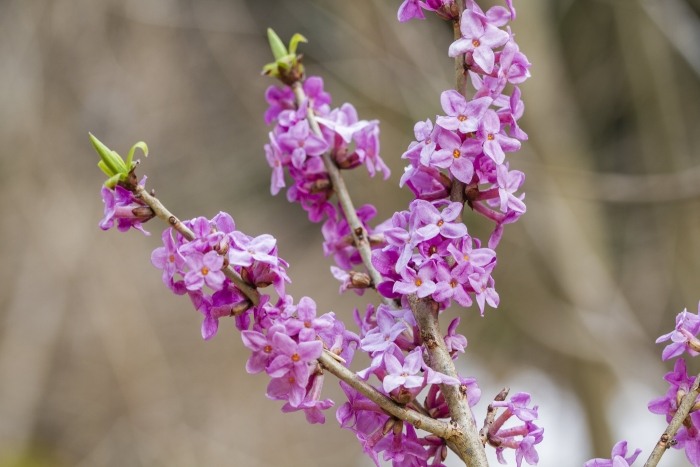February Daphne
(Daphne mezereum)
February Daphne (Daphne mezereum)
/
/

Sophie MIGLIERINA
CC BY-SA 2.0
Image By:
Sophie MIGLIERINA
Recorded By:
Copyright:
CC BY-SA 2.0
Copyright Notice:
Photo by: Sophie MIGLIERINA | License Type: CC BY-SA 2.0 | License URL: https://creativecommons.org/licenses/by/2.0/ | Uploader: sophiemiglierina | Publisher: Flickr |



























































Estimated Native Range
Summary
Daphne mezereum, commonly known as February Daphne, is a semi-deciduous to deciduous shrub native to a variety of woodland habitats, including deciduous forests and forest edges across Europe, Central Asia, and Siberia. It typically grows to 1.5 meters tall with a similar spread, featuring soft, spirally arranged leaves that are 3–8 cm long and 1–2 cm broad. February Daphne is notable for its early spring flowers that emerge on bare stems before the leaves, displaying a four-lobed pink or light purple (rarely white) perianth about 10–15 mm in diameter. The flowers are highly fragrant and attract early-season pollinators. Following the flowering period, the plant produces bright red berries that are 7–12 mm in diameter. While these berries are highly toxic to humans, they are consumed by fruit-eating birds such as thrushes, which aid in seed dispersal.
This shrub is valued for its early bloom time, providing color and scent when few other plants are flowering. It is often used in woodland gardens, shaded borders, and as a specimen plant. February Daphne thrives in full sun to part shade and requires medium amounts of water, with a preference for well-drained soils. It is relatively low-maintenance but can suffer from diseases such as leaf spots and can be prone to root rot in poorly drained soils. Gardeners should be cautious with this plant due to its highly poisonous berries and potential invasiveness outside its native range.CC BY-SA 4.0
This shrub is valued for its early bloom time, providing color and scent when few other plants are flowering. It is often used in woodland gardens, shaded borders, and as a specimen plant. February Daphne thrives in full sun to part shade and requires medium amounts of water, with a preference for well-drained soils. It is relatively low-maintenance but can suffer from diseases such as leaf spots and can be prone to root rot in poorly drained soils. Gardeners should be cautious with this plant due to its highly poisonous berries and potential invasiveness outside its native range.CC BY-SA 4.0
Plant Description
- Plant Type: Subshrub, Shrub
- Height: 3-5 feet
- Width: 3-5 feet
- Growth Rate: Moderate
- Flower Color: Pink, Purple, White
- Flowering Season: Spring
- Leaf Retention: Deciduous
Growth Requirements
- Sun: Full Sun, Part Shade
- Water: Medium
- Drainage: Medium, Fast
Common Uses
Bee Garden, Bird Garden, Border Plant, Butterfly Garden, Deer Resistant, Fragrant, Hummingbird Garden, Rabbit Resistant, Rock Garden, Showy Flowers
Natural Habitat
Deciduous forests and forest edges across Europe, Central Asia, and Siberia
Other Names
Common Names: Spurge Laurel, Spurge Olive, Paradise Plant, Mezereon, February Daphne, Daphne, Lady Laurel, Pebertræ, Gemeiner Seidelbast, Gewöhnlicher Seidelbast
Scientific Names: , Daphne mezereum, Daphne houtteana, Daphne florida, Thymelaea mezereum, Daphne mezereum var. album, Daphne mezereum var. albida, Daphne rechingeri, Daphne mezereum subsp. rechingeri, Daphne ×houtteana var. atropurpurea
GBIF Accepted Name: Daphne mezereum L.